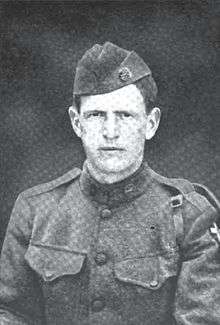Willie Sandlin
| Willie Sandlin | |
|---|---|
 Sergeant Willie Sandlin | |
| Born |
January 1, 1890 Breathitt County, Kentucky |
| Died | May 29, 1949 (aged 59) |
| Place of burial | Zachary Taylor National Cemetery, Louisville, Kentucky |
| Allegiance | United States of America |
| Service/branch | United States Army |
| Rank | Sergeant |
| Unit | Company A, 132d Infantry, 33d Division |
| Battles/wars | World War I |
| Awards | Medal of Honor |
Willie Sandlin (January 1, 1890 – May 29, 1949) was a soldier in the United States Army who received the Medal of Honor for his actions during World War I.
Biography
Sergeant Willie Sandlin was born in Breathitt County. He was the only Kentuckian to receive the Medal of Honor in World War I. Of all the American servicemen who fought during the Great War, only Sergeant Alvin C. York received more decorations for valor than Sandlin. Born of humble parents, he had the misfortune to lose his mother when he was a small boy. He grew to manhood with few advantages. At an early age he enlisted in the United States Regular Army. The hardships of youth had taught him well the lesson of taking care of himself. Straight as an arrow, with keen, alert, but steady black eyes, black hair, powerfully muscular, but not heavy built, he was a splendid type of the sturdy men who come from the Kentucky mountain counties. He was not assertive, but almost timid. But his mother was an Abner, and the Abners were among the sturdiest, most reliant stock of the old time families in Perry County. His quick black eyes and muscular frame came from his mother. He enlisted in the army in 1914 and served on the Mexican border. In 1917 he was sent to France with the 132d Infantry. Promoted to sergeant, Sandlin single-handedly destroyed three German machine gun emplacements and killed twenty-four of the enemy on September 26, 1918, at Bois de Forges. For that action, he was awarded the Medal of Honor on July 9, 1919. After the war, Sandlin returned to East Kentucky and bought a farm on Owls Nest Creek near Hyden. He and his wife, the former Belvia Roberts, were active in the Frontier Nursing Service. They had one son and four daughters. Sandlin, then 59, died on May 29, 1949, of a lingering lung infection resulting from a poison gas attack on his company in the Battle of the Argonne. He was buried in Hurricane Cemetery near Hyden. In September 1990 his remains were reburied in the Zachary Taylor National Cemetery in Louisville. Willie's wife, Belvia Roberts Sandlin, lived to be 96 years old. She died on February 11, 1999. Belvia was 47 years of age when Willie died and she never married again. In 2000, the family of Willie Sandlin donated his Medal of Honor to the Kentucky Military History Museum in Frankfort.
The Kentucky General Assembly, during the 2016 regular session, named a new bridge crossing the Middle Fork of the Kentucky River on KY 30 in the Old Buck Community of Breathitt County the "Sergeant Willie Sandlin Memorial Bridge." State and local officials gathered at Highland-Turner Elementary School in Breathitt County on June 24, 2016, to formally dedicate the bridge in Sandlin's memory and honor.[1]
Medal of Honor citation
Rank and organization: Sergeant, U.S. Army, Company A, 132d Infantry, 33d Division. Place and date: At Bois-de-Forges, France, 26 September 1918. Entered service at: Hyden, Ky. Birth: Jackson, Ky. G.O. No.: 16, W.D., 1919.
- Citation
He showed conspicuous gallantry in action by advancing alone directly on a machinegun nest which was holding up the line with its fire. He killed the crew with a grenade and enabled the line to advance. Later in the day he attacked alone and put out of action 2 other machinegun nests, setting a splendid example of bravery and coolness to his men.[2]
See also
References
- ↑ "KYTC District 10". www.facebook.com. Retrieved 2016-06-26.
- ↑ "SANDLIN, WILLIE". Army of Medal of Honor website. 2009-08-03. Retrieved 2009-08-28.
External links
- "Willie Sandlin". Claim to Fame: Medal of Honor recipients. Find a Grave. Retrieved 2009-08-28.
- "Willie Sandlin". Hall of Valor. Military Times. Retrieved 2009-08-28.